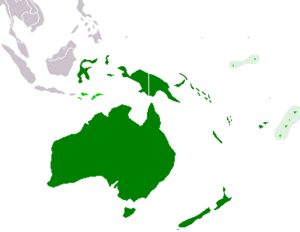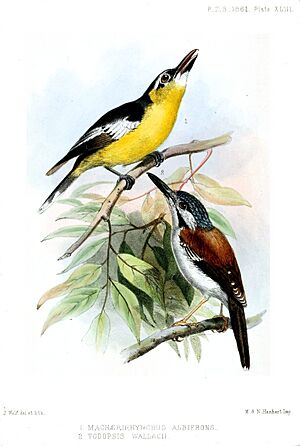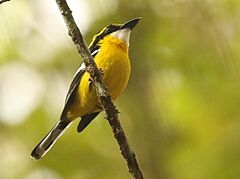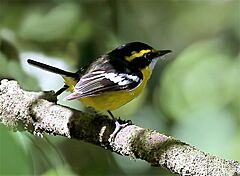Yellow-breasted boatbill facts for kids
Quick facts for kids Yellow-breasted boatbill |
|
|---|---|
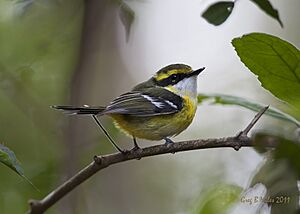 |
|
| Conservation status | |
| Scientific classification | |
| Genus: |
Machaerirhynchus
|
| Species: |
flaviventer
|
The yellow-breasted boatbill (Machaerirhynchus flaviventer) is a small bird. You can find it in New Guinea and Far North Queensland, Australia. This bird belongs to the Machaerirhynchidae family. Bird scientists, called ornithologists, know it well.
This boatbill lives in warm, wet places. It likes forests, especially those in tropical or subtropical areas. It doesn't mind how high up it lives. You can find many of these birds in their natural homes.
Contents
What Does the Yellow-breasted Boatbill Look Like?
The yellow-breasted boatbill is a unique and small bird. It is about 11 to 12.5 centimeters (4 to 5 inches) long. It usually weighs around 9 to 10 grams.
Its Special Beak
This bird has a large, black beak for its size. Its beak is wide, long, and flat. It looks a bit like a boat, which is how the bird got its name! The tip of its beak is hooked. This helps it catch insects.
Colors and Features
The underside of the boatbill is a bright yellow. This yellow color goes all the way up to its chest. This is why it's called "yellow-breasted." The area under its beak, where its neck would be, is white.
It has big, round eyes with dark black pupils. There is also a yellow stripe across its forehead, like an eyebrow. Male boatbills have a black upper body. Females are a lighter olive color. Other than that, males and females look very similar.
The bird has white stripes on its wings, called wing bars. Its tail is long and black, especially for its small body. The tail is rounded at the end and often points upwards. The yellow-breasted boatbill has average-sized legs. It has small claws on its four-toed feet.
Where Do Yellow-breasted Boatbills Live?
You can find the yellow-breasted boatbill in the Southern Hemisphere. It lives in tropical areas across all of New Guinea. It also lives in Australia, especially in the Cape York Peninsula. It has been seen in the subtropical and tropical rainforests of North Queensland. Some have even been spotted on islands near Oceania.
Preferred Homes
The boatbill is most common in rainforests. These areas have many evergreen trees and bushes. Rainforests get a lot of rain, which helps plants grow. This also attracts many insects for the bird to eat.
Boatbills like to build their nests high up in the forest canopy. This keeps them safe from predators. They only leave the canopy to find food.
They also live in gallery forests. These forests are often found near rivers and ponds. This means lots of plants and insects. Boatbills can build nests safely in bushes near riverbanks. They find many flying insects there. Sometimes, they also live at the edges of forests and in lowland areas.
Yellow-breasted Boatbill Behavior and Life Cycle
The yellow-breasted boatbill is a bit shy. Because of this, scientists don't know everything about its behavior.
Family Life
These birds often live in pairs. A male and female stay together for most of their lives. They work together to raise their young from eggs. A female boatbill usually lays two eggs. This is common for birds in this family.
The male bird usually builds the nest. However, sometimes the female helps too. Nests are built high up, from 5 to 25 meters (16 to 82 feet) above the ground. The nests can look a bit flimsy or see-through from below. But they are strong enough for two eggs and one parent.
Parents take turns sitting on the eggs. They are very careful when they switch places. The bird on the nest waits for its partner to return. When the other bird arrives, it quickly leaves the nest. The eggs are only uncovered for a few seconds. This shows how much they care for their unhatched babies.
Calls and Hunting
The boatbill's mating call sounds like a song. It sings a mix of chirps, tweets, and trills. When they are not nesting, boatbills are usually looking for food.
Their unique, boat-shaped beak helps them hunt. It's perfect for catching insects flying in the air. The hooked tip of their beak also lets them search for insects on the forest floor. After it rains, they eat earthworms and other insects found on the ground. They also find insects near riverbanks under plants in gallery forests.
How We Protect the Yellow-breasted Boatbill
The International Union of Conservation of Nature (IUCN) says the yellow-breasted boatbill is of "least concern". This means it's not currently at risk of disappearing.
This is because the bird lives in a very large area. Also, there are many of them, and their numbers are not going down. The places where boatbills live in Northern Queensland are often protected areas. There are no major natural threats to them right now.
However, scientists believe the boatbill is one of the top 100 Australian bird species that could be affected by climate change. Studying the yellow-breasted boatbill can help us learn how birds can live well alongside humans. Scientists can learn what helps these birds survive and what might threaten them in the future.
Images for kids



